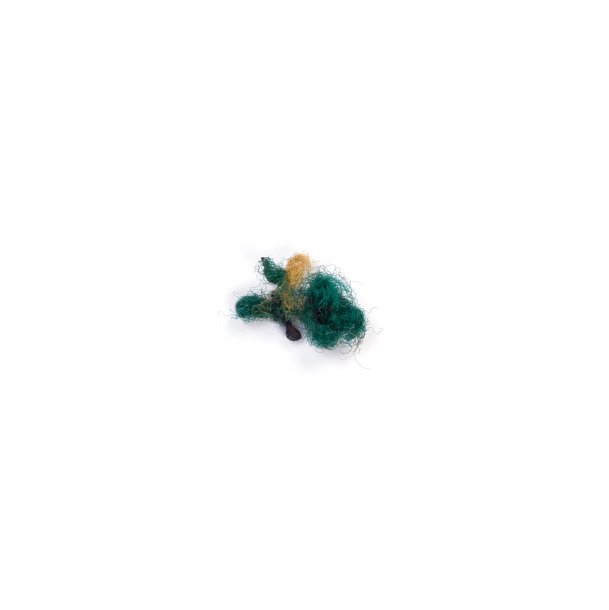Fluff is a conglomeration of individual, loose threads clinging together. It was once a textile, something that’s been made, worn and used by humans since pre-history, re-made by the machinations of London into felted clumps.
As a kid in Crouch End in the early 80s, I remember the rag-and-bone man, driving his truck, ringing his bell and collecting rubbish for selling on. Before wide use of plastics, rags, bones and metals would have been more or less the only stuff not re-used in the home.
Once you break down textile remnants you’re left with ‘shoddy’ – the short, cut fibres you can mix up and spin again. Shoddy-wool was a low-quality textile made from these rags, and the shoddy-dust, or unusable fluff was baled up and sent off as manure to places like the Kent hop-fields. Shoddy-fluff was made from plants, but to recycle synthetic fibres, like this blue and green specimen, it needs to be ground up and pelletised, ready for re-melting.
Synthetic fluff is extremely perilous for sea creatures. The micro fibres get detached and enter our water system, lodging in the soft bodies of tiny creatures. Just as bigger creatures swallow plastic bags and die from hunger, these fibres fatally interfere with the delicate processes of marine micro-life.
Fluff, left to its own devices, likes to collect in crevices, to snag in the gaps. It has more substance and can get more purchase than mere dust. It is more sociable. It comes together in spin dryer filters in strata, striated layers of lint, the geological record of your white, dark and colour washes. Fluff collects on us – in our belly buttons and between our toes, the tumbleweed of the body, finding a good place to lodge.
Phytology is one of those crevices in the city, where interesting fluff collects in eddies and tangles at the bottom of the trees, finding lodging and a safe haven from the dustman’s broom. Fluff is a conglomeration of individuals, once-woven loose threads matted or clinging together. It was once a textile, something that’s been made, worn and used by humans since pre-history, re-made by the machinations of London into a group of felted clumps.
Fluff and dust is all there is after everything has been used up. I’m old enough to remember the Rag-and-Bone Man as a kid, driving a truck round Crouch End in the early 80s, ringing his bell and collecting rubbish for selling on. Before wide use of plastics, rags bones and metals would have been the only stuff you wouldn’t re-use in the home. Once you break down textile remnants you’re left with ‘shoddy’ – the short cut fibres you can mix up and spin again. Shoddy-wool was a low-quality textile made from these rags, and the shoddy-dust, or unusable fluff was baled up and sent off as manure to places like the Kent hop-fields. However to recycle synthetic fibres like these they need to be ground up and pelletised, ready for re-melting, unless they break free of their textile web first.
Synthetic fluff is the most perilous type for sea creatures. The micro fibres get detached from textiles in washing machines and the fluff enters our waterways and seas, showing up in to ecosystems at the bottom of food-chains and at the bottom of the ocean, lodging in the small soft bodies of plankton and other creatures. As whales and turtles swallow plastic bags and die from hunger, these tiny plastic strings get stuck in and around the digestive systems of these creatures and fatally interfere with the delicate processes of micro-life.
Fluff left to its own devices likes to collect in crevices, to snag in the gaps. It has more substance and can get more purchase than mere dust, is more sociable. It comes together in spin dryer filters in strata, striated laters of lint, the geological record of your whites, darks and colours routine. Fluff collects on us, in our belly buttons and between our toes, the tumbleweed of the body, finding a good place to lodge.
Phytology is one of those crevices in the city, where interesting fluff collects in eddies and tangles at the bottom of the trees, finding lodging and a safe haven from the dustman’s broom.


